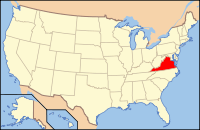Gunston Hall
|
Gunston Hall | |
 | |
|
View of Gunston Hall from the northwest | |
| Nearest city | Lorton, Virginia |
|---|---|
| Coordinates | 38°39′50″N 77°9′37″W / 38.66389°N 77.16028°WCoordinates: 38°39′50″N 77°9′37″W / 38.66389°N 77.16028°W |
| Built | 1755 |
| Architect | George Mason; William Buckland |
| Architectural style | Georgian |
| Governing body | State |
| NRHP Reference # | 66000832 |
| VLR # | 029-0050 |
| Significant dates | |
| Added to NRHP | October 15, 1966[1] |
| Designated NHL | December 19, 1960[2] |
| Designated VLR | September 9, 1969, June 27, 2007[3] |
Gunston Hall is an 18th-century Georgian mansion near the Potomac River in Mason Neck, Virginia, United States of America.[4][5] The house was the home of the United States Founding Father George Mason. It was located at the center of a 5500 acre (22 km²) plantation.[6] The construction period of Gunston Hall was between 1755[7] and 1759.[8]
The interior of the house and its design was mostly the work of William Buckland, a carpenter/joiner and indentured servant from England. Buckland later went on to design several notable buildings in Virginia and Maryland. Both he and William Bernard Sears, another indentured servant, are believed to have created the ornate woodwork and interior carving. Gunston's interior design combines elements of rococo, chinoiserie, and Gothic styles, an unusual contrast to the tendency for simple decoration in Virginia at this time.[9] Although chinoiserie was popular in Britain, Gunston Hall is the only house known to have had this decoration in colonial America.[10] In 1792, Thomas Jefferson attended George Mason at his death bed at Gunston Hall.[11] After Mason's death later that year, the house continued to be used as a residence for many years.[12] In 1868, it was purchased by noted abolitionist and civil war Colonel Edward Daniels.[13] It is now a museum owned by the Commonwealth of Virginia and open to the public.[14] The home and grounds were added to the National Register of Historic Places in 1966.
Construction
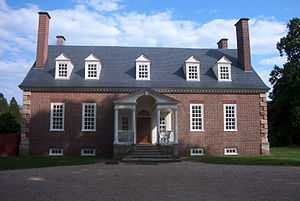
William Buckland signed an indenture with Thomson Mason, George Mason's brother, on 4 August 1755, four months after he finished as an apprentice from April 1748 to April 1755. In exchange for free passage to Virginia, room and board, and a yearly salary of twenty pounds sterling, Buckland agreed to act as a carpenter and joiner for the Masons for four years.[7]
In November, when Buckland arrived, the exterior walls of Gunston Hall were probably complete.[7] Buckland probably did design the portico overlooking the garden, in addition to much of the interior.[7] The various carvings in the mansion were probably the combined work of William Buckland and William Bernard Sears.[7] Buckland most likely provided designs for the carvings, but Sears most likely carved the wood.[7] Buckland and Sears probably worked on much of the original furniture together.[7] At the time, it was not uncommon for English architects to design furniture as well as buildings.[7]
First floor
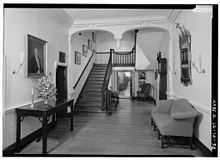
The front of the house faces northwest. The first floor of the house is divided in two by a central passage, leading from a door in the northwest to a door in the southeast, with a staircase running up on the northeast side. On the northeast side of the central passage is the primary chamber (or bedroom) in the front, and the little parlor in the back. Between the primary chamber and the little parlor is a smaller passage, leading to a service staircase and a small, side stairway. The Gunston Hall Plantation official website says that on the southwest side of the house is a parlor in the front and a dining room in the back.[9] However, the Historic American Buildings Survey says that on the southwest side of the house the dining room is in the front and a palladian room is in the back.[15][16]
The central passage is lined by six symmetrical Doric-style pilasters. A double arch, with a carved pine cone, divides the front of the passage from the back. In the front, there are four doors placed opposite one another, although one is a fake door for symmetry. The front of the hall is covered in wallpaper, while the back has raised painted paneling.[17]
The primary chamber was a private room and was less ornate than the public rooms. Toward the end of Mason's life, it was painted in emerald green, which was considered a desirable color. The windows had pocket shutters, and are believed to be the only windows in the house to have curtains during Mason's lifetime.[18]
The little parlor was private and decorated plainly. The walls were painted a neutral grey. Above the fireplace was a split pediment overmantel (a rectangle, and a partial triangle above that). During Mason's lifetime, the rectangle contained either a painting or a mirror. On either side of the fireplace are deep-shelved beaufats (niches) to store and display the tableware, with doors to secure valuable possessions.[19]
The western room (called the parlor or the dining room)[15] was a public, ornately decorated room. The walls are painted a yellow ocher, and the woodwork is Chinese-style. The wall of the fireplace has a mantel decorated with fretwork, pagoda-like scalloped moldings, as well as canopies topped by pine cone finials. Above the doors are similar canopies, which might have displayed Chinese porcelain vases or ceramic figures. The two long windows are topped by scalloped pediments, decorated with fretwork. During Mason's lifetime, three of the walls were probably wallpapered. During the 18th century, chinoese (Chinese-style) design was popular in Great Britain, however the Gunston Hall museum does not know of any other rooms in colonial America with this type of coordinated chinoiserie woodwork.[10][16]
The southern room (called the dining room or the palladian room),[15] was public, and was the most elaborately decorated in the house. The classical woodwork shows touches of the fashionable rococo design. The fireplace wall has an ornate chimney breast. On either side of the fireplace are beaufats, these ones with shallower shelves than in the little parlour, and no doors. Classical broken pediments top the chimney breast and the beaufats. The floor was made of carefully matched blind-doweled planks, an expensive feature. Egg-and-dart carved patterns surround the black-walnut entry doors. During Mason's lifetime, painted or decorated paper covered the thin pine paneling on the walls. The two windows look out onto Mason's garden.[16][20]
Second floor
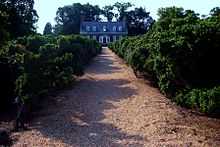
Unlike other 18th-century houses of Gunston Hall's stature, the layout of the second floor is entirely dissimilar to the floor below. A narrow passage runs sideways through the upper level, leading to seven bedchambers and a storage room. At the top of the main stairway is a tri-part arch with fluted pillars, separating the passageway from a small gallery overlooking the staircase. The smaller service staircase comes up opposite the storage room.[21]
Of the bedchambers, only the four corner rooms have fireplaces. Their fireplaces and surrounds did have some architectural detail. The corner rooms had two or three windows each, while the inner chambers only had one window each. The walls of the corner bedchambers were painted with more expensive shades, such as Prussian blue or verdigris. The attic was accessible through one of the inner bedrooms.[21]
The storage closet, or lumber room, had no exterior window, but instead received light from a window to the stairwell, as there was an exterior window above the staircase landing.[21]
Basement
Gunston Hall has a basement, which has a main passage and four rooms like the floor above it. Three staircases lead down to the basement. The basement contains four brick arched chimney supports, and nine small windows.[22][23] In 1975, a cast iron stove was excavated from the basement. The style of the stove suggests it is from the 18th or early 19th century.[24] Around 1986, a "shallow subsurface perimeter drainage system" was built about four feet (1.2 m) away from the foundation walls, due to an excess ground moisture. This significantly reduced standing water in the basement.[25]
Porches
The front porch of Gunston Hall is William Buckland's "most individualistic design", according to Great Georgian Houses of America, as copied by the Historic American Buildings Survey. The classical lines of the porch exactly follow those of a Roman medal of the Temple of Tyche in Eumenia, Asia Minor, only engraved once. It is possible Buckland saw the medal or heard it discussed while apprenticing with his uncle, a bookshop owner.[26] The porch is also quite similar to the porch of Honington Hall, near Oxford. It is possible the Honington Hall porch inspired Buckland.[27]
Garden and outbuildings

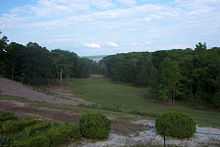
The garden was located behind the house, or on the southern side. The garden was grown above a man-made level platform where there used to be a hill, and was exactly one acre (about 4000 sq m) in area. A gravel path runs from the back of the house to the southern edge, and was twelve feet (3.7 m) wide during Mason's time period, the same width as the central passage in the house and the portico. Today, the path is narrower, crowded by boxwoods that are now about 250 years old. The path ends in an overlook extending out from the steep edge of the garden. From here, the Potomac river can be seen. The Gunston Hall museum website says that the view was more impressive during Mason's time, when the trees were cleared. The garden was most likely broken into four rectangles, with additional gravel paths running through and around it. To give the illusion from the house of all rectangles being the same size, the rectangles closer to the house were probably shorter than the rectangles farther away.[28]
The outbuildings at Gunston Hall are reconstructed. They include a kitchen, dairy, smokehouse, and laundry. They are believed to represent typical support buildings of an 18th-century plantation household.[5] George Mason owned about 90 slaves, but the places they lived have not been located.[29]
Visitors' center and museum shop
At the visitors' center, there is an 11-minute film entitled "George Mason and the Bill of Rights". The exhibit covers Mason's political career, personal life, and 18th century plantation culture. Gunston Hall is open from 9:30 a.m. to 5 p.m. EST, except for the holidays Thanksgiving, Christmas, and New Year's Day. A 45-minute tour is offered every half hour, with the last tour starting at 4:30 p.m.[5] The museum shop sells souvenirs such as books, gift items, soap, food, and toys. The museum shop's stated purpose is to educate today's citizens about 18th century life in Virginia.[6]
History
The mansion stayed in the Mason family until 1867.[30] From 1868 to 1891, it was owned by Edward Daniels, a Virginia newspaper publisher and Reconstruction Era politician, who was a former Union cavalry officer and ardent abolitionist. In 1912, it was bought by retired Sears and Roebuck executive, Louis Hertle, whose second wife was a member of The National Society of The Colonial Dames of America.[31] They set about restoring the mansion to its original plan and hosted many prominent guests. In 1949, Hertle in his will gave the property to the Commonwealth of Virginia as a museum to be run by the Colonial Dames.
Other Mason plantations
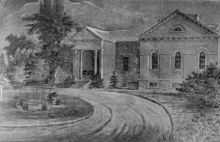
George Mason's other plantations included Hollin Hall, Woodbridge, Lexington, and Mason's Island. His son, John Mason, lived in Clermont for part of his life.[32]
George Mason gave Hollin Hall to his third son, Thomson Mason, through deeds of gift in 1781 and 1786. The land, as given, totaled 676 acres (2.7 km²). Hollin Hall is about three miles (4.8 km) southwest of Alexandria. Late in the 18th century, it was near George Washington's Mount Vernon. Thomson Mason was the first member of the Mason family to live here. Before, the land was rented out to tenants.[33] Woodbridge Plantation used to be on the Occoquan River across from Colchester. There was a ferry there. George Mason willed the land to Thomas Mason, his youngest son, in 1792.[34]
Lexington Plantation was originally part of the Gunston Hall Plantation land. Lexington was given to George Mason's first son, George Mason V. The mansion of Lexington Plantation was probably not built until after George Mason V returned from a trip to Europe in 1783.[35]
George Mason III bought Barbadoes Island from Francis Hammersly in 1717, and the island came to be known as Mason's Island. George Mason gave the island to his fourth son John Mason in 1792. Since John Mason always referred to the island as Analostan Island it came to be known by that name. During the 1790s, John ordered a summer home built there. After financial troubles, the bank foreclosed the island and John's Georgetown property in 1833. John Mason then moved to Clermont, a 320 acre (1.3 km²) property he had recently acquired, where he spent the rest of his life.[36][37]
As a namesake
Gunston Hall was the namesake of the USS Gunston Hall (LSD-5) launched in 1943,[38] and the USS Gunston Hall (LSD-44) launched in 1987.[39] Gunston Hall is also the namesake for Gunston Elementary School,[40] in Lorton, Virginia, Gunston Middle School in Arlington, Virginia,[41] as well as the former athletic mascot for George Mason University, Gunston.[42]
References
- ↑ "National Register Information System". National Register of Historic Places. National Park Service. 2007-01-23.
- ↑ "Gunston Hall". National Historic Landmark summary listing. National Park Service. Retrieved 2008-06-26.
- ↑ "Virginia Landmarks Register". Virginia Department of Historic Resources. Retrieved 5 June 2013.
- ↑ "House and Grounds". Gunston Hall Plantation official website. Retrieved 2009-09-06.
- ↑ 5.0 5.1 5.2 "Visiting Gunston Hall". Gunston Hall Plantation official website. Retrieved 2013-12-22.
- ↑ 6.0 6.1 "Gunston Hall Museum Shop". Gunston Hall Plantation official website. Retrieved 2013-02-22.
- ↑ 7.0 7.1 7.2 7.3 7.4 7.5 7.6 7.7 Beckerdite, Luke et al. (1994). "Architect-Designed Furniture in Eighteenth-Century Virginia: The Work of William Buckland and William Bernard Sears". American Furniture 1994. Chipstone. Retrieved 2006-08-31.
- ↑ "George Mason Chronology". Gunston Hall Plantation official website. 1997. Retrieved 2006-08-31.
- ↑ 9.0 9.1 "Architecturally Speaking". House Tour. Gunston Hall Plantation official website. Archived from the original on 2006-06-30. Retrieved 2006-08-23.
- ↑ 10.0 10.1 "Parlor". House Tour. Gunston Hall Plantation official website. Archived from the original on 2006-07-13. Retrieved 2006-08-23.
- ↑ Pittman, R. Carter; edited by LeFevre, Joel T (1953). "George Mason of Gunston Hall (1725 - 1792)". Rcarterpittman.org. Originally published in the Autograph Collector's Journal, Spring Convention Edition. Retrieved 2006-08-31.
- ↑ "Gunston Hall's Archeology Program". House and Grounds. Gunston Hall Plantation official website. p. 2. Archived from the original on 2006-07-14. Retrieved 2006-08-31.
- ↑ Robinson, Bertha Louisa, "Pilgrimages to American Landmarks - Gunston Hall", Journal of American History, 1910
- ↑ "Gunston Hall Plantation official website". Retrieved 2006-08-23. Also hosted on look.net.
- ↑ 15.0 15.1 15.2 "First floor plan". Gunston Hall Drawings. Historic American Buildings Survey (part of the US National Park Service). Retrieved 2006-08-24.
- ↑ 16.0 16.1 16.2 "Plan of Garden and Grounds near Gunston Hall". Gunston Hall Drawings. Historic American Buildings Survey (part of the US National Park Service). Retrieved 2007-03-14.
- ↑ "Central Passage". House Tour. Gunston Hall Plantation official website. Archived from the original on 2006-07-13. Retrieved 2006-08-23.
- ↑ "Chamber". House Tour. Gunston Hall Plantation official website. Archived from the original on 2006-07-13. Retrieved 2006-08-23.
- ↑ "Little Parlor". House Tour. Gunston Hall Plantation official website. Archived from the original on 2006-07-13. Retrieved 2006-08-23.
- ↑ "Dining Room". House Tour. Gunston Hall Plantation official website. Archived from the original on 2006-07-13. Retrieved 2006-08-23.
- ↑ 21.0 21.1 21.2 "Second Floor". House Tour. Gunston Hall Plantation official website. Archived from the original on 2006-07-13. Retrieved 2006-08-23.
- ↑ "Basement plan - Reflected ceiling plan". Gunston Hall Drawings. Historic American Buildings Survey (part of the US National Park Service). Retrieved 2006-08-24.
- ↑ "71. Detail of chimney support, east wall of basement HABS VA,30-LORT,1-71". Gunston Hall Black & White Photos. Historic American Buildings Survey (part of the US National Park Service). Retrieved 2006-08-24.
- ↑ "Recommended Objects: Heating". Gunston Hall Room Use Study. Gunston Hall Plantation official website. 2002. Archived from the original on 2006-05-08. Retrieved 2006-08-24.
- ↑ Park, Sharon C. (1996). "Diagnosing Moisture in Historic Buildings" (PDF). Cultural Resource Management: Technology 19 (7): 1, 4. Retrieved 2006-10-29. Also see Google's HTML cache.
- ↑ Prepared by Bennie Brown, Jr. "Data pages". Historic American Buildings Survey/Historic American Engineering Record. p. 4. Retrieved 2007-03-06.
- Copied from:
- the Editorial Committee and the Publication Committee. (1933). "Gunston Hall". Great Georgian Houses of America (Vol. 1 ed.). New York: The Editorial Committee. p. 264. ISBN 0-486-22491-0.
- ↑ Prepared by Bennie Brown, Jr. "Data pages". Historic American Buildings Survey/Historic American Engineering Record. p. 7. Retrieved 2007-03-06.
- Copied from:
- the Editorial Committee and the Publication Committee. (1933). "Gunston Hall". Great Georgian Houses of America (Vol. 1 ed.). New York: The Editorial Committee. p. 264. ISBN 0-486-22491-0.
- ↑ "Discovering George Mason's Garden". House and Grounds. Gunston Hall Plantation official website. Archived from the original on 2006-05-07. Retrieved 2006-08-23.
- ↑ "Gunston Hall's Archaeology Program". House and Grounds. Gunston Hall Plantation official website. p. 4. Retrieved 2007-03-14.
- ↑ "History of the mansion". Gunston Hall (official site). Retrieved 9 May 2012.
- ↑ "Louis Hertle". Gunston Hall (official site). Retrieved 9 May 2012.
- ↑ "George Mason's Plantations and Landholdings". Gunston Hall Plantation official website. Retrieved 2007-03-01.
- ↑ "Hollin Hall". George Mason's Plantations and Landholdings. Gunston Hall Plantation official website. Retrieved 2007-03-01.
- ↑ "Woodbridge". George Mason's Plantations and Landholdings. Gunston Hall Plantation official website. Retrieved 2007-03-01.
- ↑ "Lexington Plantation". George Mason's Plantations and Landholdings. Gunston Hall Plantation official website. Retrieved 2007-03-01.
- ↑ "Analostan Island". George Mason's Plantations and Landholdings. Gunston Hall Plantation official website. Retrieved 2007-03-01.
- ↑ "Clermont". George Mason's Plantations and Landholdings. Gunston Hall Plantation official website. Retrieved 2007-03-01.
- ↑ "Gunston Hall". DANFS. U.S. Naval Historical Center. 11 April 2005. Retrieved 2009-08-26. LSD-5 later served in the Argentine Navy.
- ↑ "Naval Vessel Register: USS GUNSTON HALL (LSD 44)". United States Navy. U.S. Naval Historical Center. 23 January 2006. Retrieved 2009-08-26.
- ↑ "Gunston Elementary School". Fcps.edu. 2013-02-05. Retrieved 2013-02-13.
- ↑ "Gunston Middle School". Retrieved 2009-08-26.
- ↑ http://dcist.com/2008/11/10/gw_george_mason_get_new_mascots.php; http://gomason.cstv.com/genrel/031108aaa.html. Gunston has been replaced by The Patriot as athletics mascot, but Gunston will remain in use by the university. See http://dcist.com/2008/11/10/gw_george_mason_get_new_mascots.php.
- Beckerdite, Luke et al. (1994). "Architect-Designed Furniture in Eighteenth-Century Virginia: The Work of William Buckland and William Bernard Sears". American Furniture 1994. Chipstone. Retrieved 2006-08-31. Recommended by the Gunston Hall Plantation official website Bibliography.
- "Gunston Hall Plantation official website". Retrieved 2006-08-23. Also hosted on look.net.
- "Photos and Drawings of Gunston Hall". Historic American Buildings Survey (part of the US National Park Service). Retrieved 2006-08-24.
- Park, Sharon C. (1996). "Diagnosing Moisture in Historic Buildings" (PDF). Cultural Resource Management: Technology 19 (7): 1–4. Retrieved 2006-10-29. Also see Google's HTML cache.
- Pittman, R. Carter; edited by LeFevre, Joel T (1953). "George Mason of Gunston Hall (1725 - 1792)". Rcarterpittman.org. Originally published in the Autograph Collector's Journal, Spring Convention Edition. Retrieved 2006-08-31. Recommended by the Gunston Hall Plantation official website Bibliography.
- Taylor, Bill. "Conversion Table Javascript program". Taylormade. Retrieved 2007-03-04. The metric conversions in this article are rounded based on the results of this program.
Further reading
| Wikimedia Commons has media related to Gunston Hall. |
- "Gunston Hall Bibliography". Gunston Hall Plantation Library & Archives. Gunston Hall Plantation official website. Retrieved 2007-03-02.
- Beckerdite, Luke et al. (1994). "Footnotes of Architect-Designed Furniture in Eighteenth-Century Virginia: The Work of William Buckland and William Bernard Sears". American Furniture 1994. Chipstone. Retrieved 2006-08-31.
- Prepared by Bennie Brown, Jr. "Data pages". Historic American Buildings Survey/Historic American Engineering Record. p. 55. Retrieved 2007-03-06.
- Copied from:
- the Editorial Committee and the Publication Committee. (1933). "Gunston Hall". Great Georgian Houses of America (Vol. 1 ed.). New York: The Editorial Committee. p. 264. ISBN 0-486-22491-0.
- Bisbee, M. Lauren (1974). Of Land & Labor: Gunston Hall Plantation Life in the 18th Century. Lorton, Virginia, United States of America: Board of Regents of Gunston Hall. p. 32. ISBN 1-884085-06-7.
- Pamela C. Copeland and Richard K. MacMaster (1989) [1975]. The Five George Masons: Patriots and Platers of Virginia and Maryland. Lorton, Virginia, United States of America: Board of Regents of Gunston Hall. p. 341.
- "Gunston Hall". National Historic Landmarks Program (United States). Retrieved 2007-03-14.
| |||||||||||||||||||||||||||||
| |||||||||||||||||||||||||||||||


